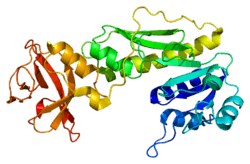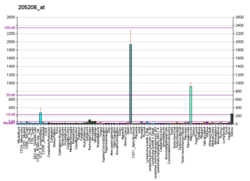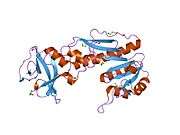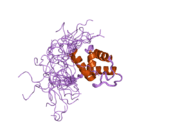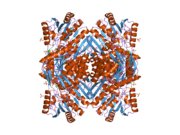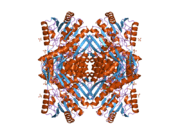ALDH1L1
10-formyltetrahydrofolate dehydrogenase is an enzyme that in humans is encoded by the ALDH1L1 gene.[5]
The protein encoded by this gene catalyzes the conversion of 10-formyltetrahydrofolate, NADP, and water to tetrahydrofolate, NADPH, and carbon dioxide. The encoded protein belongs to the aldehyde dehydrogenase family and is responsible for formate oxidation in vivo. Deficiencies in this gene can result in an accumulation of formate and subsequent methanol poisoning.[5]
References
- GRCh38: Ensembl release 89: ENSG00000144908 - Ensembl, May 2017
- GRCm38: Ensembl release 89: ENSMUSG00000030088 - Ensembl, May 2017
- "Human PubMed Reference:". National Center for Biotechnology Information, U.S. National Library of Medicine.
- "Mouse PubMed Reference:". National Center for Biotechnology Information, U.S. National Library of Medicine.
- "Entrez Gene: ALDH1L1 aldehyde dehydrogenase 1 family, member L1".
External links
- Human ALDH1L1 genome location and ALDH1L1 gene details page in the UCSC Genome Browser.
Further reading
- Lee KM, Lan Q, Kricker A, et al. (2007). "One-carbon metabolism gene polymorphisms and risk of non-Hodgkin lymphoma in Australia". Hum. Genet. 122 (5): 525–33. doi:10.1007/s00439-007-0431-2. PMID 17891500.
- Stevens VL, McCullough ML, Pavluck AL, et al. (2007). "Association of polymorphisms in one-carbon metabolism genes and postmenopausal breast cancer incidence". Cancer Epidemiol. Biomarkers Prev. 16 (6): 1140–7. doi:10.1158/1055-9965.EPI-06-1037. PMID 17548676.
- Lim U, Wang SS, Hartge P, et al. (2007). "Gene-nutrient interactions among determinants of folate and one-carbon metabolism on the risk of non-Hodgkin lymphoma: NCI-SEER case-control study". Blood. 109 (7): 3050–9. doi:10.1182/blood-2006-07-034330. PMC 1852210. PMID 17119116.
- Oleinik NV, Krupenko SA (2004). "Ectopic expression of 10-formyltetrahydrofolate dehydrogenase in A549 cells induces G1 cell cycle arrest and apoptosis". Mol. Cancer Res. 1 (8): 577–88. PMID 12805405.
- Strausberg RL, Feingold EA, Grouse LH, et al. (2003). "Generation and initial analysis of more than 15,000 full-length human and mouse cDNA sequences". Proc. Natl. Acad. Sci. U.S.A. 99 (26): 16899–903. doi:10.1073/pnas.242603899. PMC 139241. PMID 12477932.
- Krupenko SA, Oleinik NV (2002). "10-formyltetrahydrofolate dehydrogenase, one of the major folate enzymes, is down-regulated in tumor tissues and possesses suppressor effects on cancer cells". Cell Growth Differ. 13 (5): 227–36. PMID 12065246.
- Hong M, Lee Y, Kim JW, et al. (1999). "Isolation and characterization of cDNA clone for human liver 10-formyltetrahydrofolate dehydrogenase". Biochem. Mol. Biol. Int. 47 (3): 407–15. doi:10.1080/15216549900201433. PMID 10204077.
- Suzuki Y, Yoshitomo-Nakagawa K, Maruyama K, et al. (1997). "Construction and characterization of a full length-enriched and a 5'-end-enriched cDNA library". Gene. 200 (1–2): 149–56. doi:10.1016/S0378-1119(97)00411-3. PMID 9373149.
- Maruyama K, Sugano S (1994). "Oligo-capping: a simple method to replace the cap structure of eukaryotic mRNAs with oligoribonucleotides". Gene. 138 (1–2): 171–4. doi:10.1016/0378-1119(94)90802-8. PMID 8125298.
- Champion KM, Cook RJ, Tollaksen SL, Giometti CS (1994). "Identification of a heritable deficiency of the folate-dependent enzyme 10-formyltetrahydrofolate dehydrogenase in mice". Proc. Natl. Acad. Sci. U.S.A. 91 (24): 11338–42. doi:10.1073/pnas.91.24.11338. PMC 45226. PMID 7972060.
- Johlin FC, Swain E, Smith C, Tephly TR (1989). "Studies on the mechanism of methanol poisoning: purification and comparison of rat and human liver 10-formyltetrahydrofolate dehydrogenase". Mol. Pharmacol. 35 (6): 745–50. PMID 2733692.
This article is issued from Wikipedia. The text is licensed under Creative Commons - Attribution - Sharealike. Additional terms may apply for the media files.
